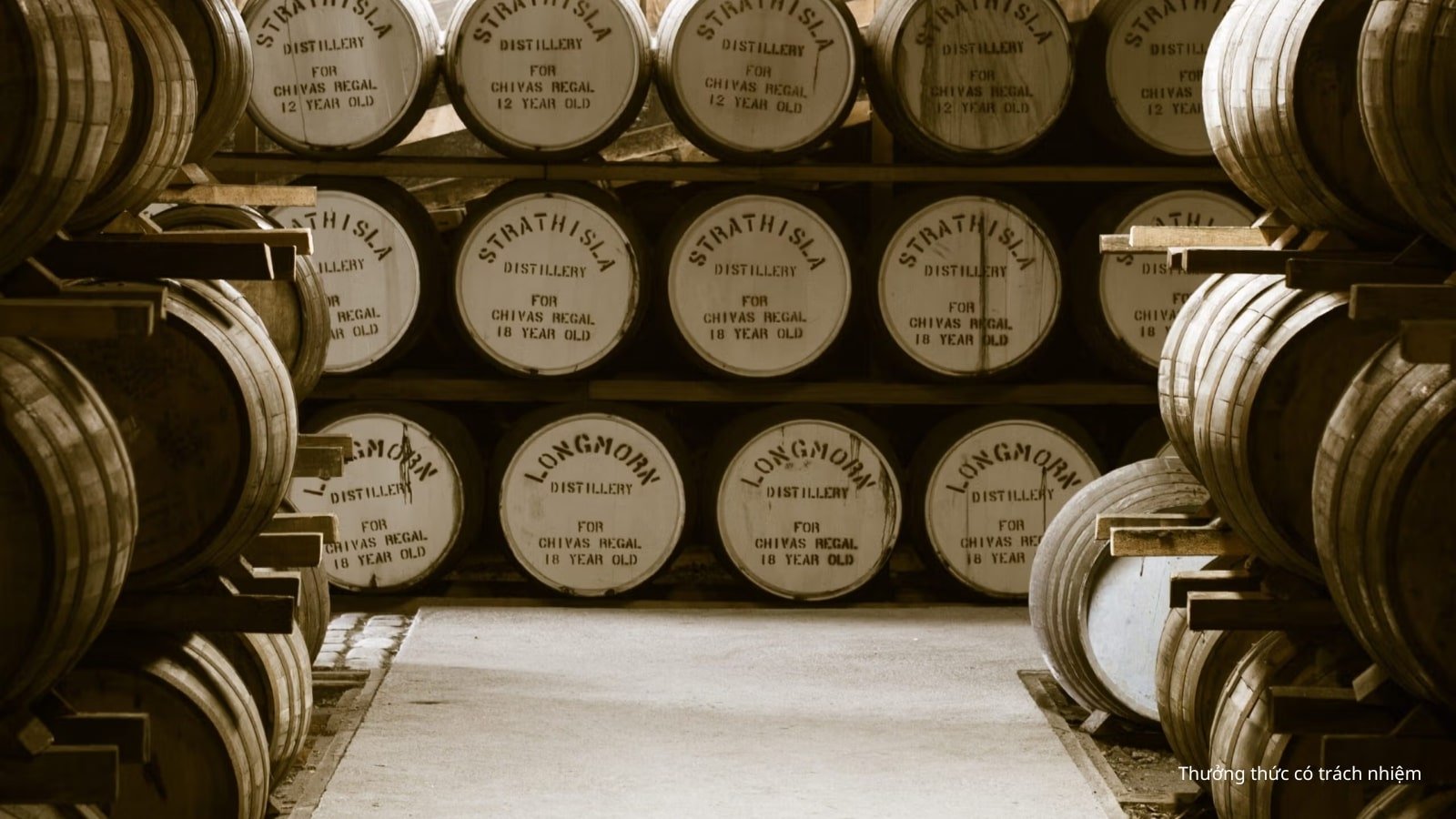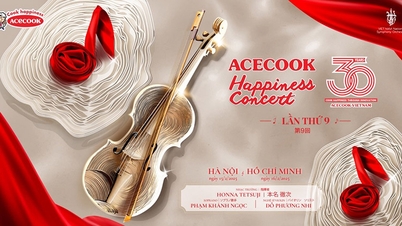1. Common flavor groups in Whiskey
In the world of spirits, Whiskey always stands out for its incredibly rich, multi-layered and incredibly sophisticated flavors. From strong smoky aromas to sweet fruit flavors, each type of Whiskey is a symphony of flavors that makes the connoisseur amazed. Specifically, some common flavor groups in Whiskey are as follows:
1.1. Smoke and peat incense
This is the most recognizable aroma group in Whisky. Smoke and peat aromas often bring a strong, wild and classic feeling, often classified according to the feeling as:
- Fresh Wood Smoke: Pleasant light burning wood scent.
- Peat Smoke: Darker, earthier and with hints of a rich cigar aroma.
- Other smoky aromas: Burnt wood aroma, dark roasted coffee aroma.
Traditional Islay whiskies are prominent representatives of this group with their intense smoky aromas and distinctive peat notes. Some Speyside whiskies can also have a smoky aroma from charred oak casks.
1.2. Fruit flavor
Named after the description from wine lovers, fruity aroma is one of the most favorite flavor groups with many diverse classifications such as:
- Tropical fruit flavors: mango, banana,...
- Orchard fruit flavors: apple, pear,...
- Citrus fruit flavors: grapefruit, orange, lemon,...
- Dried fruit flavors: raisins, dates,...
This group of aromas brings a fresh feeling, making the whisky richer and easier to drink. The fruity flavor is considered the typical flavor of high-quality whisky from the Speyside region of Scotland.
1.3. Spicy flavors
Spicy flavors bring a warming sensation, stimulating the sense of smell and taste, giving Whisky more depth and complexity. Spicy flavors are often classified as follows:
- Warm sweet spices: cinnamon, cloves, nutmeg.
- Spicy spices: ginger, pepper, dried chili.
What unique flavor notes can you look for in a Highland (Scottish) Whiskey or an American Rye Whiskey?
1.4. Sweet flavors
The sweet taste in Whisky is extremely diverse and rich, it can be sweet and mild or sharp, it is one of the main flavors that create the unique characteristics of Whisky in the world of spirits. Sweetness often helps to harmonize other flavors and makes Whisky easier to drink.
Sweet flavors usually come from:
- Sweet flavors of confectionery: honey, chocolate and pastry.
- Caramel Sweetness: caramel flavor, fruit syrup, sugar candy.
- Vanilla Sweetness: Vanilla and marshmallow flavor.
Among them, the sweetness of honey is one of the typical flavors of the wines produced from Speyside distilleries.
1.5. Woody and dark chocolate scent
Woody and dark chocolate aromas bring a sense of depth and maturity, often contributing to the lingering aftertaste in the palate of the Whisky connoisseur. This is also a group of flavors that show the age of the wine and the quality of the barrel, including:
- Young wood flavor: Slightly harsh, has the smell of newly cut resin, strong aroma.
- Old wood flavor: Has a dry, astringent tannin smell but is subtly infused in every drop of wine.
- Bitter dark chocolate flavor: Rich, slightly bitter but long-lasting and full-bodied.
Speyside Whiskies aged over 15 years like Chivas Regal 18 are the perfect representation of this flavour group with a blend of dark chocolate, old wood flavour mixed with smooth sweetness and a hint of familiar fruit and spice.
From intense smokiness to sweet fruitiness, each Whisky is a unique symphony of flavors.
2. Elements that help create flavor in Whisky
The rich and distinctive flavour of Whisky is the result of a complex combination of ingredients, production technology and rigorous aging techniques. Specifically, the factors that help create the flavour in Whisky include:
2.1. Production materials
Raw materials are the first foundation that shapes the identity of each type of Whisky.
Cereal
Depending on the recipe, Whiskey can be distilled from one or more grains such as barley (malt), wheat, corn or rye. Each type creates a distinct flavor nuance:
- Barley and Malt: Rich toffee flavor.
- Corn: Brings a mild vanilla sweetness and maple syrup sweetness.
- Wheat: Tastes like whole wheat bread with honey.
- Rye: Spicy flavor with characteristic depth of flavor.
In addition, the way the ingredients are processed, such as roasting and drying, also greatly affects the flavor of the wine. Using peat as a fuel when drying malt and grains can permeate the ingredients, creating a smoky flavor as well as promoting the development of stronger grain flavors. In addition:
- Islay malt whiskies can have additional seaweed, tar and salt notes due to the peat used being made from marine vegetation and sea salt.
- Whisky from the Orkney Islands often has a smoky, floral aroma due to the peat being made up largely of heather.
- Highland peat varies depending on location but contains more decaying vegetation so tends to impart a more wood-fire-like smoky character to the whisky.
Water source
Although it only affects about 2% of the flavor of the wine, the quality of the water used to make Whisky still plays an important role in the fermentation and distillation process, especially in terms of mineral content and pH - one of the factors that greatly affects the fermentation results.
2.2. Wine brewing process
Oak barrel maturation affects 75% of the final flavour of a whisky. This delicate maturation process is the reason why fine whiskies always possess the unique flavour and depth that connoisseurs always seek.
Specifically, the factors that affect the aging process on the flavor of Whisky:
Oak wood type
- American Oak: High in vanillin, which often imparts vanilla and caramel flavors to Whisky.
- European Oak: Contains a lot of tannins, giving the Whisky a prominent woody aroma and a strong, slightly bitter taste.
Incubation time
- Aging: Complex chemical reactions occur between the distillate and various wood compounds, creating subtle woody and bitter chocolate flavors.
- Short Aging: The aroma of Whisky is often grainy and sweet with rich fruit and vanilla flavors.
How to handle compost bin
- Toasting: Contributes vanilla, caramel and a slight spice to the wine.
- Burning: Brings out the smoky aroma and sweeter flavors like caramel and honey.
Wine brewing environment
- Aging near the sea: Thanks to the infusion of the sea's aroma, the wine often has a very distinct salty flavor.
- Warm weather aging: Wines tend to develop more esters, giving them rich fruit flavors.
Type of compost bin
- First barrel: Intense woody and spicy aromas.
- Barrels that have previously aged wine or other spirits: Remove strong wood flavors and bitter tannins, bringing out some of the flavor of the previously aged spirit.
2.3. Fermentation process
Fermentation is the process of converting sugar into alcohol, but it is also where most of the unique layers of flavor in Whisky are created. The type of yeast used, the time and temperature of fermentation play an important role in creating the final flavor of Whisky.
During this stage, the yeast produces a series of volatile aromatic compounds (esters), responsible for the aroma notes:
- Fruity flavors: apple, pear, banana, citrus, pineapple.
- Floral scent: lavender, violet, rose.
- Herbal and cereal aromas: grass, biscuit, malt.
Each strain of yeast produces a different set of flavors. Combined with the production formula of each distillery, each line of Whisky created will give a completely different layer of flavor.
2.4. Distillation process
Distillation is the process of filtering and concentrating alcohol through evaporation and condensation. This is also where Whiskey selects and refines each layer of flavor to obtain the most delicate flavor of alcohol.
- Foreshots are often discarded due to impurities.
- The heart is the quintessence containing many fruity esters as well as grassy and cereal aromas.
- Feints can be retained in part to further develop the smoky flavor.
The distillation vessel material, usually made from copper, also plays a role in removing sulfur compounds, making the Whisky smoother and easier to drink.
2.5. Effects of the preparation process
With Blended Whisky, the blending process is the final step to balance and create flavor. The blender will choose aged Whisky with different characteristics (maybe different barrels, different years of aging, different ingredients...) to blend so that the overall flavor combination is harmonious and characteristic of the brand.
Thanks to this blending technique, layers of aromas such as vanilla, burnt wood, baked goods, dried fruits or light smoke can be arranged alternately, creating a depth and subtle complexity that makes the drinker sip many times to fully explore .
The taste of Whisky is the result of a complex combination of ingredients, production technology and strict aging techniques.
3. Suggestions on how to enjoy and feel the flavor of Whisky
To fully appreciate the depth and complex flavors of each drop of Whiskey, you can refer to some of the following tasting suggestions:
- Drink neat or add a few drops of water, do not mix with ice immediately to best experience the color, viscosity, aroma and characteristic flavor of each Whiskey line.
- Choose the right glass to capture the full aroma of the wine, such as a Tulip or Glencairn glass with a wide base and narrow mouth.
- When enjoying Whisky, gently rotate the glass in one direction to expose the alcohol to the air, releasing the aroma molecules. Then, place your nose near the edge of the glass, inhale gently to let the aroma gradually penetrate your sense of smell.
- Enjoy each small sip to let the wine spread throughout your mouth and touch the taste buds from the tip of your tongue, up to your palate and throat. Hold the wine in your mouth for a few seconds to feel the texture and viscosity of the wine. After swallowing, pay attention to the aftertaste of the wine. A quality Whisky will leave a long, smooth and deep aftertaste.
Enjoy slowly, sip by sip, to fully appreciate the complex flavors of Whisky.
Whiskey is delicious but only truly valuable when you know how to enjoy it properly. Hopefully the above article has helped you better understand the flavor structure of Whiskey, helping you to enhance your experience and appreciate every moment of enjoying the art of wine making.
Enjoy responsibly. Do not share this content with anyone under 18.










![[Photo] General Secretary To Lam attends the 80th Anniversary of the Cultural Sector's Traditional Day](https://vphoto.vietnam.vn/thumb/1200x675/vietnam/resource/IMAGE/2025/8/23/9f771126e94049ff97692935fa5533ec)




























































































Comment (0)